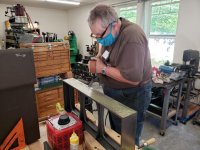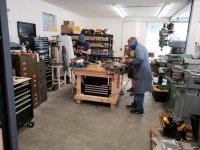Edit: I fixed the embedded images.Originally they did not show up perhaps due to there being several hours between writing the post and actually posting it.
sfriedberg,
Thanks for stepping in for me.I spent a long day at the foundry molding, setting up the furnace, melting and pouring and then doing the inevitable cleanup.I couldn't have said it better.
Matt, thanks for the kind words. I agree that Grant did a superb job of machining the square.
The short answer is no I do not have a website for SE sales. If I were a businessman, I would. But, my main focus has been improving the quality and variety of straightedges that I make. Soon I will work on my eBay listings which I have not kept current—-my bad. Anyone wanting a SE can contact me via PM or email
[email protected]. I much prefer email as PM’s are so limited.
I do offer PM members a 10% discount and for folks who buy one and then complete a bona-fide scraping class (for instance, Rich’s class) PM members get an additional 20% discount upon completion of the class for a total of a 30% discount to promote the craft of scraping. The 30% discount is one-time per person for one SE. The 10% is offered on multiple SE’s (This sounds like lawyer-speak, but I’ve had questions)
I currently have:
8” prisms/level/straight edges  18“ prism/level/SE/parallels
18“ prism/level/SE/parallels![IMG_6271[1].jpg IMG_6271[1].jpg](https://www.practicalmachinist.com/forum/data/attachments/231/231981-74ed43b867a7253fa12d6f7ac53d8ec9.jpg) 36” broad-based camelback SE’s
36” broad-based camelback SE’s  48” broad-based camelback SE’s
48” broad-based camelback SE’s Precision Square 30x12x4
Precision Square 30x12x4
Interestingly,metalmagpie just machined his and it came out at a shade over 37 pounds. As a raw casting it is 52 pounds.
I do machine the 8, 18, and 36" straight edge. The last 36 I did a week ago was between .001 and .0015 of flat. That has been fairly typical of machined results though I quote .oo4' of flatness.. I machine them from about 20 pounds to 25.5 pounds per the buyer's preference.
Denis





![IMG_6271[1].jpg IMG_6271[1].jpg](https://www.practicalmachinist.com/forum/data/attachments/231/231981-74ed43b867a7253fa12d6f7ac53d8ec9.jpg)







